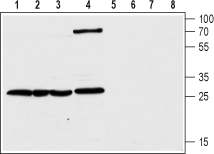Overview
- Peptide (C)RGFTIPEAFRGVHR, corresponding to amino acid residues 195-208 of human CLIC1 (Accession O00299). Intracellular, C-terminus.

 Western blot analysis of human colorectal adenocarcinoma HT-29 (lanes 1 and 5), transplantable human carcinoma cell line T-84 (lanes 2 and 6), human pancreatic carcinoma PANC-1 (lanes 3 and 7) and rat kidney (lanes 4 and 8) lysates:1-4. Anti-CLIC1 Antibody (#ACL-021), (1:200).
Western blot analysis of human colorectal adenocarcinoma HT-29 (lanes 1 and 5), transplantable human carcinoma cell line T-84 (lanes 2 and 6), human pancreatic carcinoma PANC-1 (lanes 3 and 7) and rat kidney (lanes 4 and 8) lysates:1-4. Anti-CLIC1 Antibody (#ACL-021), (1:200).
5-8. Anti-CLIC1 Antibody, preincubated with CLIC1 Blocking Peptide (#BLP-CL021).
 Expression of CLIC1 in human colorectal adenocarcinoma HT-29 cellsImmunocytochemical staining of fixed and permeabilized human colorectal adenocarcinoma HT-29 cells. A. Cells were stained with Anti-CLIC1 Antibody (#ACL-021), (1:200), followed by goat anti-rabbit-AlexaFluor-594 secondary antibody (red). B. Cell nuclei were visualized using Hoechst 33342 (blue). C. Merge of the two images.
Expression of CLIC1 in human colorectal adenocarcinoma HT-29 cellsImmunocytochemical staining of fixed and permeabilized human colorectal adenocarcinoma HT-29 cells. A. Cells were stained with Anti-CLIC1 Antibody (#ACL-021), (1:200), followed by goat anti-rabbit-AlexaFluor-594 secondary antibody (red). B. Cell nuclei were visualized using Hoechst 33342 (blue). C. Merge of the two images.
- Edwards, J.C. and Kahl, C.R. (2010) FEBS Lett. 584, 2102.
- Ashley, R.H. (2003) Mol. Membr. Biol. 20, 1.
- Cromer, B.A. et al. (2002) Eur. Biophys. J. 31, 356.
- Ulmasov, B. et al. (2007) BMC Cell. Biol. 8, 8.
- Jung, J.J. and Kitajewski, J. (2010) J. Angiogenes. Res. 2, 23.
Chloride intracellular channel (CLIC) is a family of proteins encoded by six different genes (CLIC1-6)1-3.
The localization of the various CLIC channels remains elusive and controversial since they can be either found in a soluble form in the cytoplasm or as integral membrane proteins (in intracellular compartments such as the nuclear membrane or the endoplasmic reticulum for example, or associated with the plasma membrane) via their single transmembrane domain1.
When membrane associated, CLIC channels indeed function as ion channels (enabling the passage of Cl- ions). Non-channel functions are also attributed to CLICs and include cell cycle regulation, cell differentiation, and apoptosis. These different roles depend on whether CLICs are membrane bound or cytosolic1.
CLIC1, which was first identified in nuclear membranes, is detected in the epithelia of airways, the gall bladder, pancreas, stomach, small intestine and colon4. CLIC1 was also found to be expressed in the endothelium where it plays a role in cell growth and migration5.
Application key:
Species reactivity key:
Anti-CLIC1 Antibody (#ACL-021) is a highly specific antibody directed against an epitope of the human protein. The antibody can be used in western blot and immunocytochemistry applications. It has been designed to recognize CLIC1 from mouse, rat, and human samples.
